How To Navigate The Obstacles of Engagement on LinkedIn
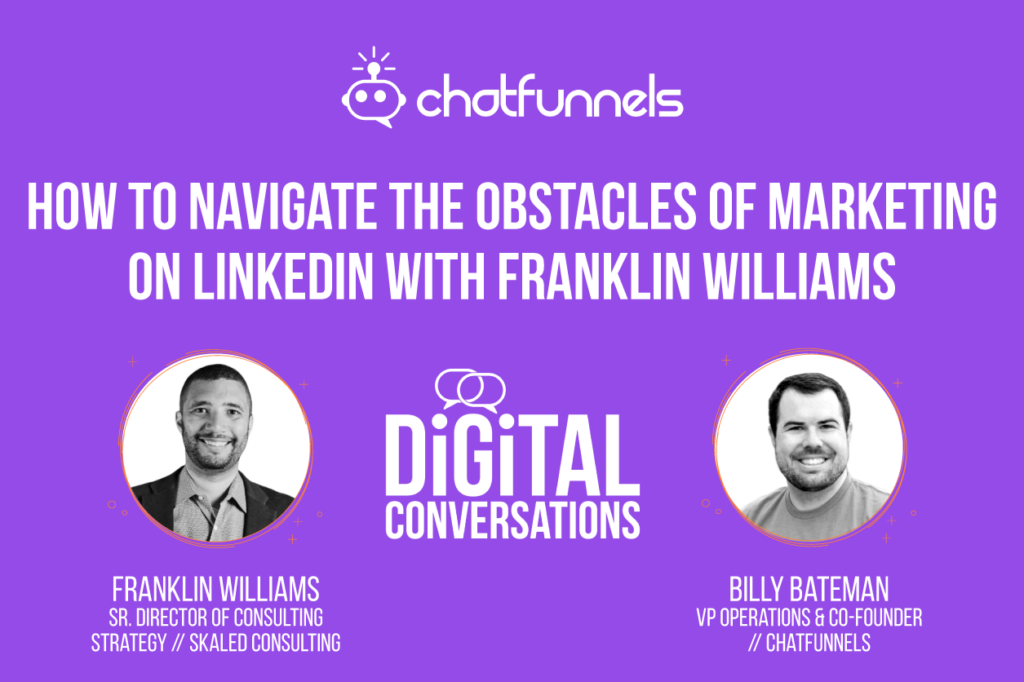
This week on Digital Conversations, Franklin Williams gives Billy insight into how to use LinkedIn as an effective marketing tool. Many salespeople and marketers make vital mistakes when trying to traditionally create engagement on LinkedIn.
Guest: Franklin Williams – Franklin is the Senior Director of Consultant Strategy at Skaled Consulting. He has extensive knowledge in decision science and optimizing LinkedIn engagement. Feel free to reach out to him on here!
Listening Platforms:
Transcript
Billy: Alright, everyone, welcome to the show today. Today, my guest is Franklin Williams, senior director at Skaled Consulting. Franklin, thanks for joining me.
Franklin: Yeah, it’s my pleasure. Glad to be here.
Billy: Yeah, I’m excited. Today we’re going to talk about driving demand on LinkedIn with conversational education. But before we hop into that, I just want to learn a little bit about you and about Skaled. So Franklin, can you just start telling us a little bit about yourself and your journey to where you got to today?
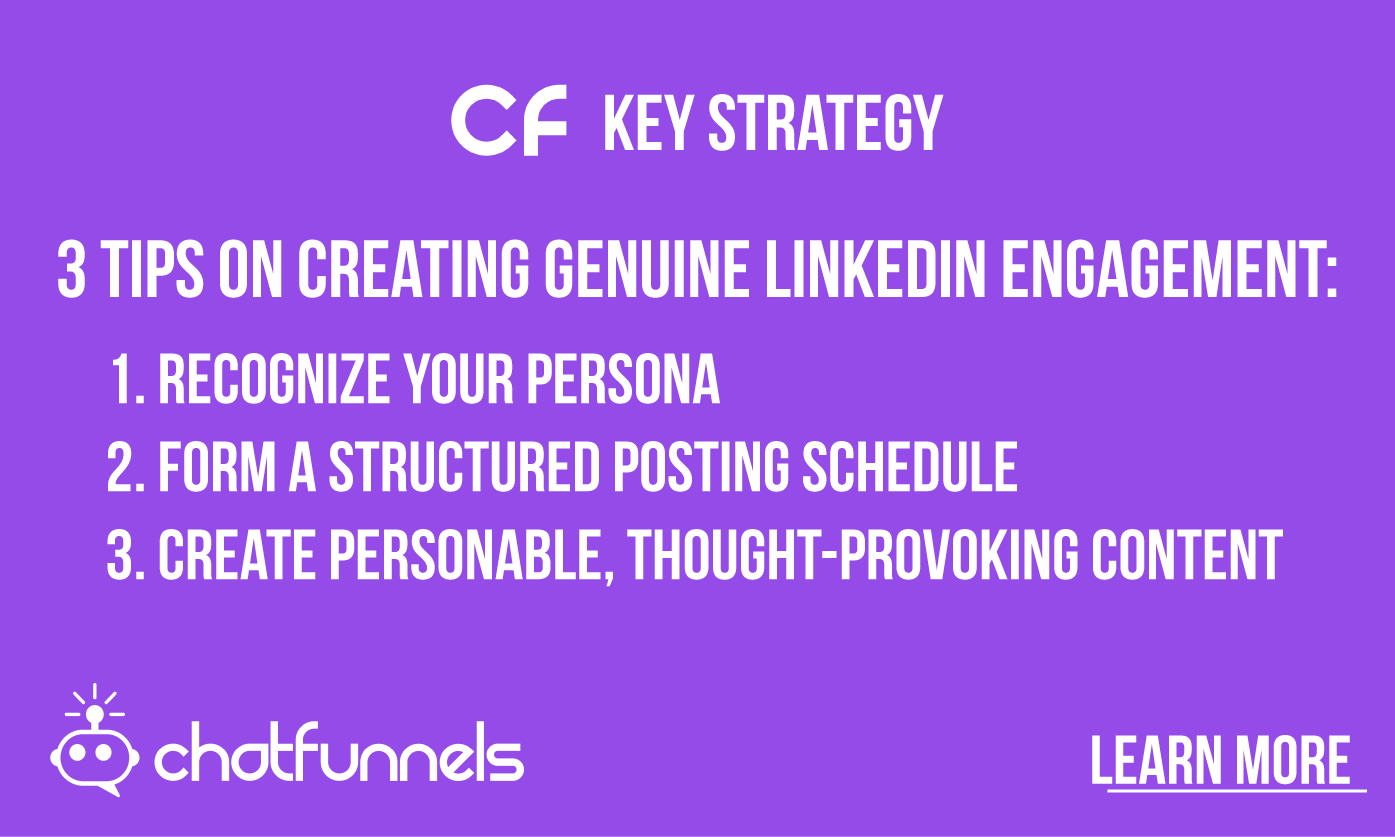
Introduction to Franklin
Franklin: Yeah, sure. You know, it’s been a kind of a wild ride, but what I recognize is that I really love solving problems. So when I was introduced to Jake, it was kind of a natural fit, you know, we were trying to figure out how to scale up Skaled Consulting practice and figure out how to really drive insight into our clients.
And we’ve been doing it all across the board from a growth standpoint, you know, whether it’s quick and easy touches and helping a sales team refine their process or really in depth, enterprise wide methodology transformation. We’ve really been starting to touch it, all of it. So it’s just super exciting time for us, particularly right now. This pandemic is forcing us all to think differently about how we approach the market.
Billy: Yeah, for sure, for sure. So can you tell us just about Skaled Consulting and what you guys do?
Franklin: Yeah. So we’re a growth- focused consultancy. And our goal is to really help bridge the gap from current state to ideal state, in whatever form that means. So we go out and help companies that are in any stage of growth. Whether it’s an early stage series A/B growth. or later stage more difficult to turn, you know, enterprise style growth and help them figure out how to bridge those gaps.
And we’ve been doing it in a bunch of programmatic ways. Lately, it’s been very much focused around how to transform businesses from, you know, ad-hoc transactional selling into a more education and thought-based, focused, strategic model. And then also figuring out how to programmize that approach in businesses that still have very customized touches.
So how do you attract properly? How do you manage properly? How do you manage up and down? And how do you make sure that your teams are asking the right questions ,while putting their own personal spin on everything, but driving accountability, you know, all the way up the stack and all the way down the stack?
Billy: Awesome, man. Those are good challenges to be tackling right now. So before we hop into, well, you already touched on which is you know, using content to drive demand and sales, I always ask everybody this question. So if we’re going to look you up on social media, and try to figure out who Franklin is, what’s something we wouldn’t know about you?
His Journey
Franklin: Yeah, that’s a great question. And you, you probably find out pretty quickly that I didn’t start in consulting. You know, a lot of consultants start their careers early in consulting or find it in their 60s. And I got really lucky and I didn’t go for a huge firm, I didn’t necessarily go for you know, fancy smaller but extremely high price boutique firm.
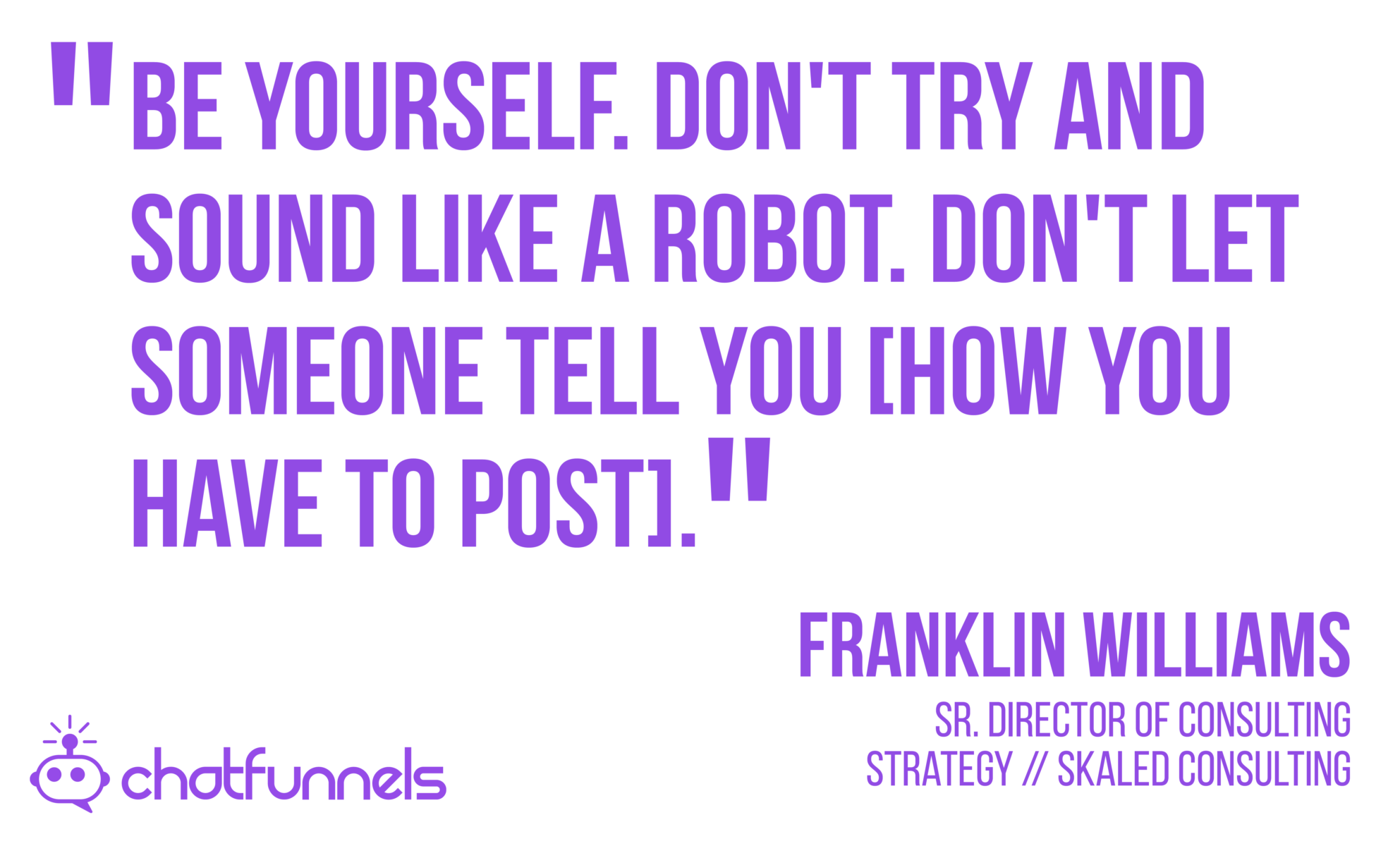
I went from selling to consulting on my own, not by choice, but by necessity, just given the market in the mid 2010s. And using that as an engine to figure out what I really wanted to do. And I consider myself lucky because they didn’t just take a consulting job to be a consultant without practical experience. So I mean, you’ll see a lot of practical experience translating to consulting, which is directly tied to that practical experience, which, I’m very grateful for, at this point in my career.
Billy: Yeah, no consulting, you know, we started out as a consulting practice. And, man it is interesting work. It’s challenging, but, you learn a lot about what you like and what you don’t like, very quickly. And it’s a great way to really just learn and kind of boost your career if you’re not gonna stay in it forever. You learn so much more as a consultant than just you know, being on a team and having like, okay, here’s your thing, your own. For whatever reason, just you know, consulting, you only what you kill, so you gotta be more aggressive.
So, okay, well, let’s hop into driving demand on LinkedIn with conversational education. So this was the topic you pitched me on, on having a conversation, I really like it because more so now than ever, we’re engaging people digitally from the beginning. There’s not a lot of trade shows going on right now where you can go and just meet people and strike up a conversation and a relationship. So first, give me an overview of this, this conversational education on LinkedIn.
Franklin: Yeah, and maybe it’s helpful to go even further back and talk about how LinkedIn has been used today to frame the difference. When you think about LinkedIn, the first thing that comes to mind for me as an example is in messaging. You know, you get on you basically get one on one touchpoints that are synonymous to, you know, marketing or spam emails. And it’s, it almost feels more invasive, because it’s personal one to one and it’s in an area where you’re supposed to be having conversations. You’ve seen this.
Oh, given that you run a podcast, I imagine you get like dozens of these a day and it’s exhausting. Plus, it costs money. You’re spending money every month to ship garbage that people don’t want. And, you know, I always ask people this question, you know, what’s the first thing that you think? Just gut reaction ,when you get a new message?
Billy: They’re trying to sell me something.
Franklin: Yeah, they’re trying to sell me something one, and then two, I don’t want to talk to this company, if this is how they engage. So, what we’ve recognized is that, especially and it’s become highlighted during this pandemic. If you take a step back and think about how people really want to engage, they want to have a conversation and they want to learn. The world today, information just everywhere. We walk around with miniature activated computers in our pockets.
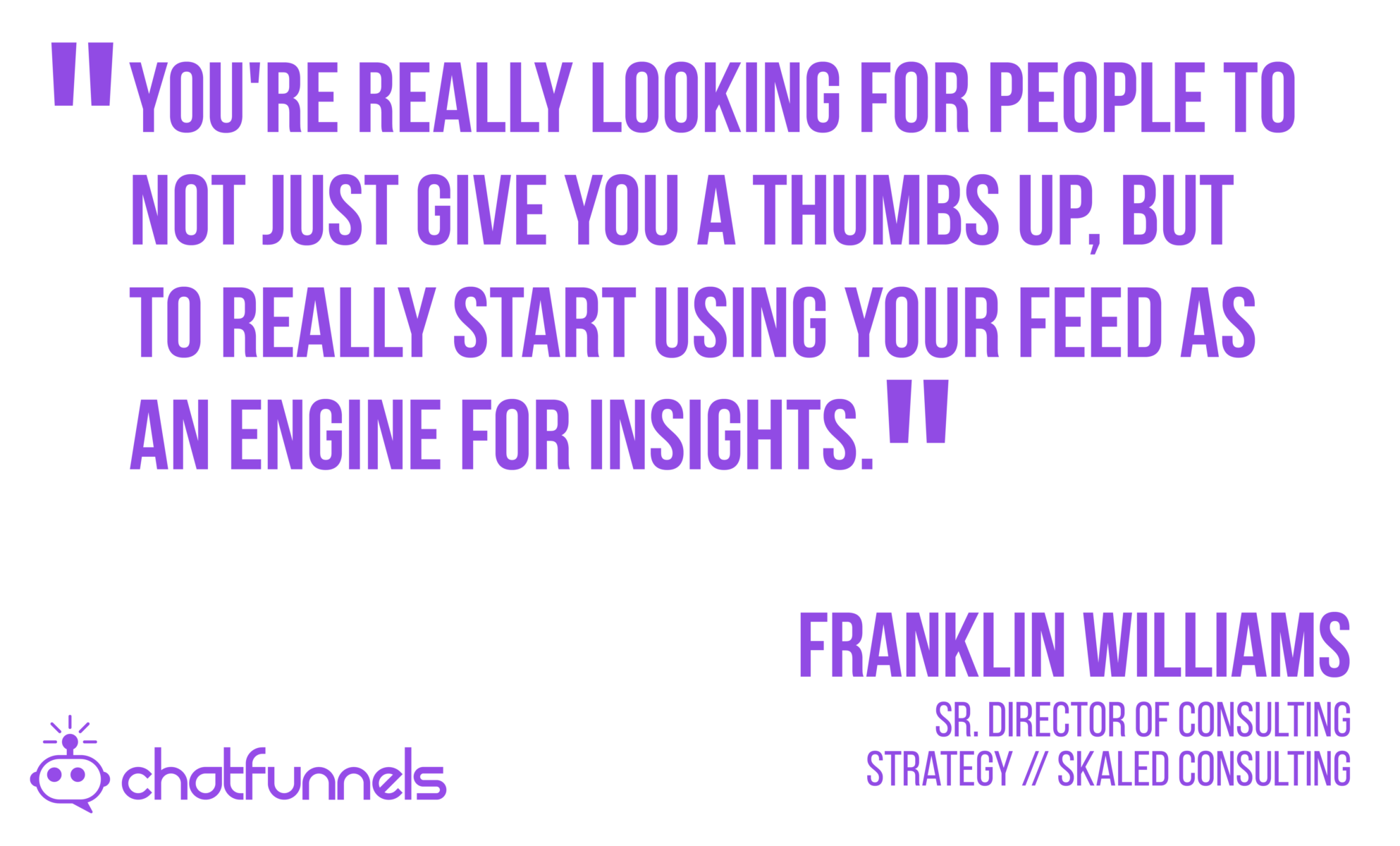
I don’t need someone to sell me something. I need someone to teach me what something is and how it’ll be useful. So when you look at what LinkedIn really is, it’s an active perpetual network of executives, experts, and thought leaders who are all in one place trying to learn from each other and share things. Unfortunately, it’s become a massive, you know, kind of marketing headache. But it’s starting to come back. And especially now when we can’t get face to face in the most, we have are one to many zoom conferences. This is the first area where we’re really able to go back and forth and keep it focused on business, as opposed to, you know, the Facebook’s of the world, which are much more social and persona driven. Does that give a little bit of an overview?
Billy: So when you’re trying to start these conversations, you know, we’re not sending the Hey, I hope the play is not add them, then send a LinkedIn message, Oh, you No, let me tell you about how great we are. How you start the conversation and do it well?
Engagement 101
Franklin: Yeah, that’s a really good question. So, you know, let’s start at the very beginning. When I’m looking to figure out how to engage. I’m looking for the target audience that I want to hit. And that doesn’t necessarily mean, you know, let me go find every tech group in advertising market, it means let me go figure out the people who care about the things that I’m thinking about. So first things first, as every good salesperson does, recognize your ICP and persona, and go figure out what groups, areas, corners of LinkedIn that they’re posting in, because there are groups on LinkedIn, and join them.
Then you need to start being programmatic. What we like to do, whether it’s once a week, five times a week, ten times a week, set a schedule, and decide how much and how often you’re going to post. So I’ll go on for example, and you know, say okay, I’m going to post on Monday and Thursday at 10am every week, and I just write out over the weekend the post that I’m going to make.
Now there’s a specific framework to what every post should look like. But you really want to communicate your brand, in whatever format is. And that could be the brand doesn’t you as an individual that could be your brand as an accompany. That could be the brand doesn’t you as the CEO of your company, or whatever your role happens to be if you’re posting. Or even a salesperson, but recognize how you want to communicate yourself and how you want to be perceived. And then set your schedule. It’s all about being programmatic and following discipline, discipline, discipline, discipline. You can’t skip a week, you can’t not post because you chose Sunday was a great day and then decide your annoyed because its Sunday. It’s all about consistency and setting expectations.
So that’s kind of the framework of how I think about this in terms of starting a conversation finding the group I identify your ICP and persona, find the group, set your schedule, post your comments in a way that’s there are ways that you can post specifically that the LinkedIn algorithm promotes. And we can talk about that later. But, you know, make sure that you’re following these guidelines. And you’ll start to see responses. But the number one thing is discipline. The number two thing is be yourself. Post your thoughts, post your ideas, post questions that are all related back to the group that you’re in. Because you want them to see what you’re posting and you want them to engage.
Billy: Okay, so I just want to drill in a little bit and recap. The first part here, get in the groups that have your ideal customer profile in there. And then just stick to that schedule twice a week. Do you find like, it’s twice a week kind of the magic number? Or is that just you know, a good cadence? What do you think on frequency?
Franklin: Yeah, I think if you’re a sales rep, honestly, twice a week is probably plenty. You know, we see a lot of executives who post three, four times a week. I see people who are, you know, Monday, Wednesday, Friday, Saturday or Sunday, pick a day and they just post the same time every day. Some people create more structured programs around it. So like, here’s the weekend update. It’s really around the level of engagement that you want.
And the type of engagement that you want. For me, once or twice a week is plenty. For most salespeople, if you’re if you’re conked on leads, and you have a slow to adopt product, maybe you want to do twice a week, because and just build it into your weekly schedule. That’s a totally viable thing to do. And it just becomes a part of your weekly cadence of outreach.
Billy: Okay, okay. And then when you’re, you talked about, you know, finding your voice, and it’s got to be authentic. And I agree with you like, if you’re just doing like canned posts every week, it’s not authentic, no one’s gonna engage. But what have you found to be most effective? Is it posing questions to the group? Is it sharing content? You know, what are the most effective strategies in what you’re putting into your post?
Content Strategy
Franklin: Yeah. So that’s, that’s also a really great question. And when I think about this, I kind of think to myself, how can I schedule this so that I’m constantly posting something like a week over week that’s consistent. So what some people might do, for example, is Monday, they’ll post a question that they open up to a group of people. For example, you know, this weekend I was out on the golf course and something really struck me. Enter, Enter. So you want a little break. So it’s very clear. how people are reading your message. Why do you think SDRs are undervalued today?

I’m recognizing that that we just don’t have enough focus on their personal development. And I just find it really interesting and can’t seem to get a straight answer. Comment below. That could be your Monday posts and something in that light every week. Thursday, you want to do the opposite. You know, we’ve been talking about this, this and this, you should go out and try this, this and this because thinking this way will help get people to engage with you sooner, or whatever it is. And you want to tailor it to the industry that you’re in with the knowledge that you have.
The result, if you do it in the right place, is that you’ll start to see a lot of engagement but people will start to respond. You know, hey, yeah, great. Cool. I agree. I totally like what you’re saying. This is brilliant. I love it when you start seeing people comment back and forth in your feed. Because someone makes a comment that’s disagreeing or disparaging or negative. And six other people hop in to say read disagree, here’s why it works. And this is what we’re thinking. Because you’re getting engagement and conversation. Over time those turn into other things. But like that’s, that’s what you’re really looking for people to not just give you a thumbs up, but to really start using your feed as an engine for insights.
Billy: Great. So when you talked about getting people to engage with each other in the comments, how do you leverage those posts yourself to engage them? You know, those women that are going to be prospects for you in the conversation and eventually into your funnel?
Franklin: Yeah, so it’s an interesting approach. And some people do this really, really well. Others not quite so much. But the thing to remember is that nothing here is immediate. Especially when you just start, you’re building your LinkedIn brand. And you’re starting to cultivate the audience that you ultimately want to be engaging with on a more one to one basis. You might have 1000 people engage with you. None of them message you personally.
On the other hand, you might have 10 engage with you and they all engage with you because they really value your insight. That said, when you start trying out and like social engaging on LinkedIn beyond the programmatic, trackable messages, you won’t really see people engage with you for anywhere from two to three months. Like they’ll engage but you won’t start to get that one on one engagement and don’t try and convert upfront.
You try and convert up front, you’re burning opportunities and you’re burning leads. You want to get repeat people coming back to you that ultimately recognized somewhere along the line that you can offer a solution to what they’re asking for. So, you know, the way I think about it is you go on your whole life without engaging with people in this in this methodology. Why rush because it’s a longer term, longer play strategy. Eventually, you want to move your insights to tie a little bit more toward what you do every day. Every week or two I’ll drop in, or will recommend you will drop in, for example, you know, @company here, we’re thinking about things this way we do it because blank, blank blank. How do you look at this? And that could be your weekly question.
You do a little plug for yourself, and you get people starting to engage. You don’t really want to reach out, aside from Hey, I loved your comment. We’d love to connect. Something like that every now and then with people who you start to remember and see posting on your on your posts consistently. If you’re regular, the same people come back every week. And the LinkedIn algorithm actually rewards you for recognizing that you want to do things consistently and programmatically and it brings your posts up to the top. But the realism is that you want people reaching out saying, Hey, I was thinking about this. What are your thoughts? Do you have some time to talk? That’s like the golden egg. And the bullet shot to getting a deal moving forward, or at least getting close enough to where a deal down the line might happen.
Billy: Awesome. Yeah, it makes sense to not go for the kill right off the bat on LinkedIn and to be consistent. So the algorithm though whether you’re that’s always a hotly debated topic and they change it, you know, it seems like one thing will work and then it doesn’t work. What are your tips if you know everyone’s trying to figure out how do I get to the top of the feed besides consistency? Anything else?
Franklin: Yeah, there’s a couple of key things you can do. Number one, resist the urge to hashtag all day long. I don’t put more than three. You get demoted for too many overtime. Number two, never post a link in the post, always post your link in the comment. So talk about what it is go into the comment or you note at the bottom link in the comments. Number one, it drives people to your comments to drive up posting. Number two, it cleans up your post and makes it look less like a share or an advertisement or something else that you’re doing. And it doesn’t necessarily promote you, but it doesn’t demote your post. Number three, think about how you post, both psychologically and algorithmically. LinkedIn likes text only posts that are series of short sentences. So sentence one, return return. Sentence two return return.
Over time, it gets long, so people have to hit more, which eventually shows them comments and pushes other stuff out of the feed. Number two, for whatever reason, the tool just likes it. It’s just a really easy way for the tool to recognize that you’re posting in a way to get engagement. You can put in videos, you know, every now and then. But the bulk of your text of your posts should be text. Number four. And a big one is consistency. That discipline is loved by the algorithm. And it works for the people that are better utilizing the algorithm. But my biggest tip for most people, would be to engage somebody who understands the algorithm better than it changes every, every couple of months at the latest, sometimes every couple of weeks.
Last year, I believe it changed 14 times. And of those 14, I think it was like eight or after August. So, you know, you start to think about how much it can change at once. If they’re doing, you know, an algorithmic update and pushing it down to the tool. You can’t keep up, unless you really know what you’re doing. So, you know, find someone who gets it, whether they’re a social media manager who specializes in the tool and tracks the updates or, you know, consulting firms do this, marketing firms do that. And help and have them basically help you understand when change comes because you’re not going to want to do this on your own. It’s exhausting.
Billy: Trying to keep up with this algorithm is is crazy. Unless it’s your full-time job. Okay, so what, you know, you’ve walked us through the basics of the play like, why does it work though? Is my question?
Navigating The Algorithm
Franklin: Yeah, that’s a great question. And I’ve now said that everything’s a great question and because they are, you know, one of the first things here is something that salespeople have started to recognize more and more and more over the last really five years. People don’t want to be sold to anymore. They just don’t. You know, people know they have problems but in today’s landscape, you know, I mentioned earlier data is available everywhere. It’s in your hand and they come with it, frankly, knowing more competitive knowledge and some reps and knowing more about your product than some people do themselves. The result is that they want to see their problems reflected by what people are putting out in the world.
So, nobody wants to come up to you and have you just kind of sell them features and functionality. They want to understand what the features and functionality actually do. And, you know, I like to think of it as like a conference. We go up to people and try and talk to someone to help them talk to us about how their product helps. But when you get someone who’s just telling you about the product or just trying to schedule a meeting, you just want to walk away. When you’re doing this online, the best way to think about it is that you’re doing the one to one in person.
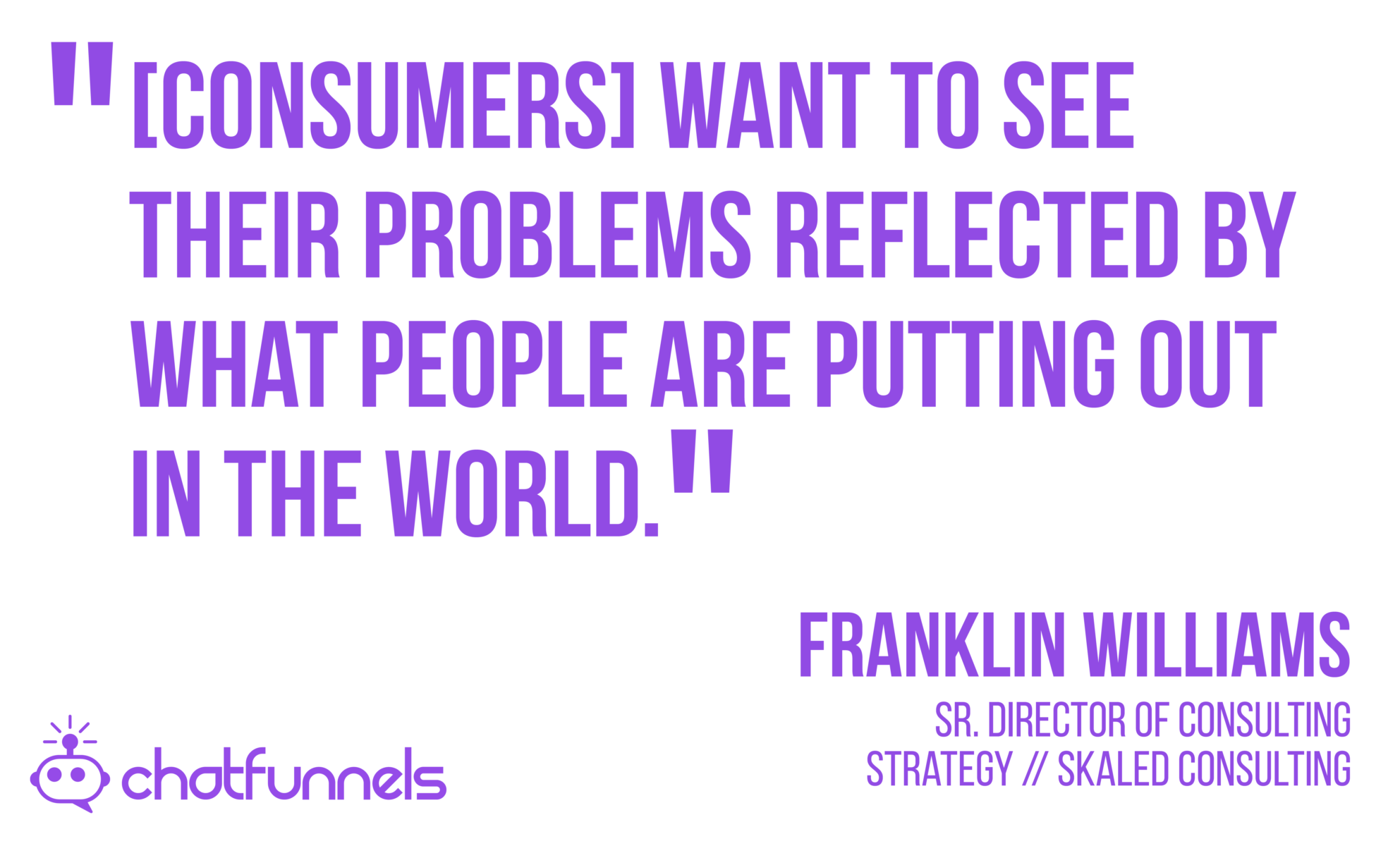
Think of it like you’re at a show, at a trade show. You’re talking to someone at a desk, and you really want to have that direct face to face conversation, learning, updating your skill set, getting a little bit extra, you only want to be sold to if you engage first. So if you think about it that way, it’s a direct reflection of what actually happens in the world shifted to the internet, which we have preconceived notions about. So you know, to sum it up quickly it works. Because it’s human psychology. And it’s the same thing that we’re doing in sales, we just have to think about it translated to sales, as opposed to a social media platform.
Billy: Oh, it makes sense. So I’ve got a couple more questions before we wrap up, but one of them is, what do you find the most difficult part about implementing the strategy?
Discipline = Engagement
Franklin: It’s getting people to do the repeated pieces over and over and over again. Some simple tasks that people don’t like to do. They don’t like to define a schedule and stick to it. They don’t like that consistent posting, they don’t want to track analytics. You know, it’s not an easy platform to track because analytics aren’t public. Like a lot of other platforms, so you do, you need to do a lot of manual tracking to make it work.
People don’t want to learn conversion metrics and how to track those either. But the thing that I think really gets tough is that people don’t like to expose themselves. They don’t want to put themselves out to their network and sound stupid. The realism though, is that we all feel that way. And it takes a conscious choice, just like doing cold calls to get up, post, and put yourself out there. So I’d argue the single most tough point here, aside from discipline, is getting over that hump. Once you’re over the hump. It’s the discipline aspect.
Billy: Yeah, that that, that makes sense. Consistency’s tough but first off, just getting going and kind of finding your voice is got to be tough as well. If this is brand new to you, okay. So what is one, one piece of advice you have for anybody that’s getting started? They kind of know the play. But if you’re gonna say, okay, just remember this one thing as you get going, what would it be?
Franklin: Yeah, be yourself. Don’t try and sound like a robot, don’t let someone tell you this is how you have to post. Don’t just go in trying to be a business advocate and you know, drive deals. Relax, be honest, and be yourself. People want to know who you are and what you have to share. Otherwise, they’ll just go take a Google and see who posts you know, the most interesting stuff with in a blog somewhere in a company site. So yeah, you know, transparency, honesty, post what’s on your mind, post the questions you’re asked during sales calls, whatever, just be you.
Billy: Okay. Well, Franklin, this has been really good. Really appreciate it. You’ve shared a lot of good knowledge with us. If somebody wants to get in touch and continue the conversation, what’s the best way for them to reach out?
Franklin: Yeah, shoot me an email at Franklin@skaled.com. I’m happy to help. You know, and I’m always just happy to sit back and chat with people too if you’ve got any questions or thoughts,
Billy: Okay, man, thank you so much and we’ll chat later.
Franklin: Yep, my pleasure.
